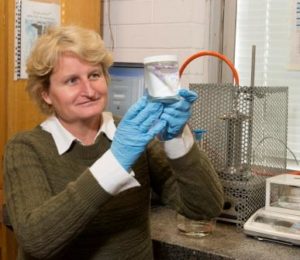
A major problem facing desalination plants worldwide could soon be solved by nanotechnologists from Flinders University.
The University has been granted a provisional patent through Flinders Partners, the commercialisation arm of the University, for an additive that prevents biofilms from clogging up membranes used in the desalination of seawater.
The provisional patent is between Flinders University, SA Water and Adelaide-based global renewable energy company Wind Prospect.
Flinders Associate Professor Amanda Ellis, who is leading the research, said the additive can be easily and cheaply incorporated into the manufacturing of reverse osmosis membranes.
These film-like, synthetic polymer membranes help produce pure water by filtering out salt and other effluent materials from the ocean under high pressure, yet the main drawback of reverse osmosis membranes is that they cannot be reused and need frequent replacing due to blockages.
“The problem with reverse osmosis membranes is biofouling, which occurs when microorganisms accumulate and grow on top of the membrane and stop water from flowing through,” Associate Professor Ellis said.
“This means the membranes have to be cleaned more frequently and it also drives up energy consumption because you have to increase the pressure in the membranes to get the same amount of freshwater through,” she said.
“But the major issue is that the membranes are not recyclable so when there’s biofouling they don’t last as long.”
Associate Professor Ellis said the additive – which can be integrated into the membrane manufacturing process for just a few cents per membrane – makes the surface of the membrane appear “neutral” so organisms do not recognise the surface and therefore keep moving through the saline flow stream.
She said laboratory tests have confirmed the additive removes nearly all biofouling from the membrane while having no impact on salt rejection.
Flinders has partnered with a membrane manufacturer who is now testing membranes containing the additive, with a key aim for the membranes to be used in South Australia’s desalination plants.
Associate Professor Ellis said the technology is both cost effective and importantly, environmentally friendly.
“These new membranes lower energy use because you don’t need to apply as much pressure to maintain the flow rate, you don’t need to clean the membranes as often because there’s virtually no biofouling and you don’t need to replace them as often, which reduces environmental waste.
“Biofouling is a problem in every desalination plant worldwide but the beauty of our technology is that it’s just an added chemical in the membrane manufacturing process – there’s nothing complicated about it and the cost is insignificant from a manufacturer’s perspective.”
Associate Professor Ellis said she hoped to lodge an application for full patent by April 2014.
The project was initially funded through a $60,000 grant from the South Australian Department for Manufacturing, Innovation, Trade, Resources and Energy in December 2012.

